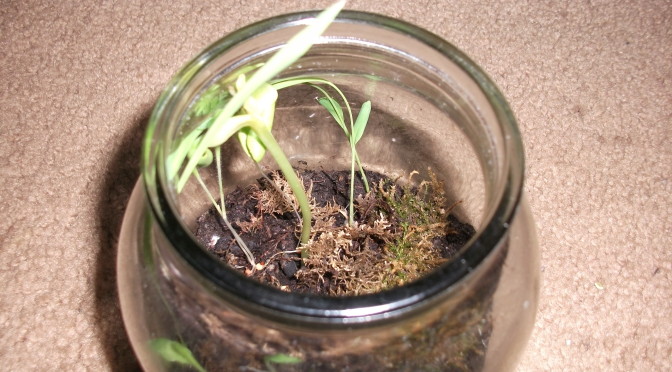Terrarium! Nature in a Candy Jar.

This post is different from all of my previous projects which are primarily electronics oriented, and it isn’t even a new project per say. I started this terrarium last year using a glass jar that originally contained some candy, and filled it with compost and moss. It worked well at first, but eventually the moss stopped growing and started to turn brown despite the fact that I kept it adequately watered. I left the jar in this state for a fairly long time until I noticed a small centipede living inside of it a few weeks ago. Upon closer inspection I noticed several other insects and invertebrates including small snails, a worm, and some small flies. Feeling bad about letting their tiny habitat descend into such a decrepit state, and realizing I couldn’t just release them outside at this time of year, I decided to try and revive my Terrarium.
I have a few hypotheses for why my initial attempts at this project failed, one of the first being my use of water directly from my household taps. Like most municipalities, our water is chlorinated for public health reasons, and it is a definite possibility that the frequent influx of chlorine into such a small and contained ecosystem was harming it’s inhabitants. To correct for this, I’ve decided to use the water from our temporary indoor aquarium that houses the fish we normally have in our backyard pond during the summer. This has the added benefit of giving my terrarium a boost in available nutrients.
A second possibility is that despite my best efforts to keep the terrarium adequately moist without drowning it, I misjudged and either under- or over-watered it. I haven’t implemented a proper solution for this potential issue yet, but it has led me to consider a future Arduino project that can quantitatively measure the soil moisture of my terrarium, and eliminate the need for subjective and qualitative assessments. Luckily for me, someone has already worked out a functional and cost effective solution for this.
The last issue I though of was that by only including moss in my Terrarium, there was a lack of biodiversity that made it susceptible to excessive growth by micro organisms or fungus. This seemed to be supported by the fact that some of the dead moss eventually started to turn an odd white color, with a slight change in its visual texture. To fix this, I simply decided to throw in some bird seed. I know from our backyard feeder that the seeds the birds cast away or don’t eat grow into a variety of grasses and grains during the spring and summer.
From the pictures I’ve taken over the past couple weeks the birdseed is clearly growing well, and the moss is starting to turn green again. It’s already clear that the jar will be too small for the grasses, let alone the sunflower to grow to full size. Hopefully they will be able to survive in the limited space. It is still too early to say whether this second attempt at making a terrarium out of a candy jar will work out, but my hopes are high, and I intend to post updates later on. I am also getting excited about the possibility of extending this project by building some sort of web enabled monitoring system with the previously mentioned moisture sensor, and perhaps a temperature and light sensor if possible.